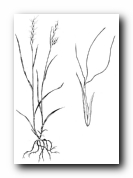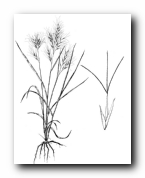

40" Rows:
Broadcast:
Sandy:
Loam:
Clay:
Habit: Annual.
Culms: Tufted, wiry, erect or ascending, much branched at the base,
10-15 cm. tall (in depauperate specimens
sometimes nearly simple).
Blades: Short, 3-7 cm. long, scarcely 1 mm. wide, the lower mostly flat, the
upper involute, scabrous.
Sheaths: Loose, much shorter than the internodes.
Ligule: Small, hairy.
Inflorescence: Panicles 5-12 cm. long, narrow, few-flowered, simple, the
lateral ones often sessile and partially enclosed in the sheaths.
Spikelets: Few, 7-9 mm. long, 1-flowered, narrow.
Glumes: About equal, or the first a little shorter, 6-8 mm. long, scabrous
on the keel and more or less scaberulous on the back, often toothed
and mucronate.
Lemmas: Without the awn 5-6 mm. long, 3-nerved, somewhat compressed
above, firm, narrow, rigid, strongly convolute, callus short, rather blunt,
sparingly pubescent, column obsolete, central awn 3-6 mm. long,
spirally 1-2 coiled at the base, bent horizontally or somewhat reflexed, the
lateral awns a continuation of the lateral nerves, erect, usually about 1 mm. long.
Palea: Thin, included by the lemma.
Habitat: Sandy soil, dry open ground. August-September.
Special Notes:
Poverty Threeawn [Aristida divaricata] Information